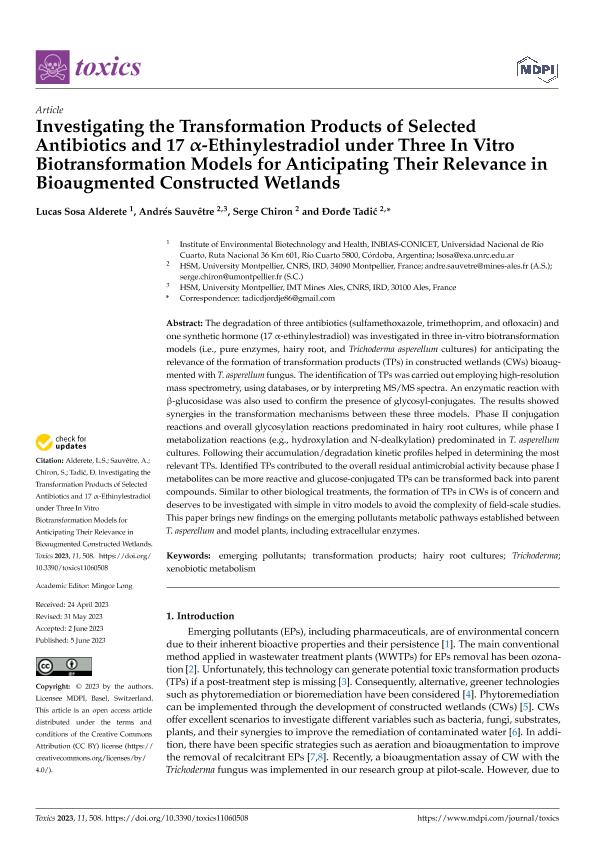Artículo
Investigating the Transformation Products of Selected Antibiotics and 17 α-Ethinylestradiol under Three In Vitro Biotransformation Models for Anticipating Their Relevance in Bioaugmented Constructed Wetlands
Fecha de publicación:
06/2023
Editorial:
Multidisciplinary Digital Publishing Institute
Revista:
Toxics
ISSN:
2305-6304
Idioma:
Inglés
Tipo de recurso:
Artículo publicado
Clasificación temática:
Resumen
The degradation of three antibiotics (sulfamethoxazole, trimethoprim, and ofloxacin) and one synthetic hormone (17 α-ethinylestradiol) was investigated in three in-vitro biotransformation models (i.e., pure enzymes, hairy root, and Trichoderma asperellum cultures) for anticipating the relevance of the formation of transformation products (TPs) in constructed wetlands (CWs) bioaugmented with T. asperellum fungus. The identification of TPs was carried out employing high-resolution mass spectrometry, using databases, or by interpreting MS/MS spectra. An enzymatic reaction with β-glucosidase was also used to confirm the presence of glycosyl-conjugates. The results showed synergies in the transformation mechanisms between these three models. Phase II conjugation reactions and overall glycosylation reactions predominated in hairy root cultures, while phase I metabolization reactions (e.g., hydroxylation and N-dealkylation) predominated in T. asperellum cultures. Following their accumulation/degradation kinetic profiles helped in determining the most relevant TPs. Identified TPs contributed to the overall residual antimicrobial activity because phase I metabolites can be more reactive and glucose-conjugated TPs can be transformed back into parent compounds. Similar to other biological treatments, the formation of TPs in CWs is of concern and deserves to be investigated with simple in vitro models to avoid the complexity of field-scale studies. This paper brings new findings on the emerging pollutants metabolic pathways established between T. asperellum and model plants, including extracellular enzymes.
Archivos asociados
Licencia
Identificadores
Colecciones
Articulos (INBIAS)
Articulos de INSTITUTO DE BIOTECNOLOGIA AMBIENTAL Y SALUD
Articulos de INSTITUTO DE BIOTECNOLOGIA AMBIENTAL Y SALUD
Citación
Sosa Alderete, Lucas Gastón; Sauvêtre, Andrés; Chiron, Serge; Tadic´, Ðorde; Investigating the Transformation Products of Selected Antibiotics and 17 α-Ethinylestradiol under Three In Vitro Biotransformation Models for Anticipating Their Relevance in Bioaugmented Constructed Wetlands; Multidisciplinary Digital Publishing Institute; Toxics; 11; 6; 6-2023; 1-16
Compartir
Altmétricas




